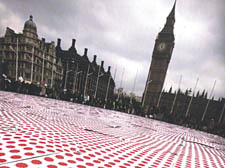|
|
 |
| |

100,000 drops of blood: Parliament Square, February 2006 (detail) |
From stamps to anti-war protest – Gentleman’s art
The delicate draughtsmanship and undisputed artistry of David Gentleman has been deployed with stunning effect to an unusually wide range of works, writes Dan Carrier
Design: David Gentleman.
By Brian Webb and Peyton Skipwith. £14.95
WHEN actor Maggie Smith was starring in Alan Bennett’s stage version of his work The Lady in the Van, she was given an odd piece of direction. She was asked to look at a quick sketch done by one of his neighbours to get the peculiar pose of her character, Miss Shepherd, exactly right.
The neighbour happened to be the artist David Gentleman and, as Alan Bennett writes in a foreword to a new book in the Design series from the Antique Collectors’ Club charting Gentleman’s work, “...he caught her in a familiar pose, feet splayed out in her version of ballet’s number one position and so exactly that when Maggie played Miss Shepherd I was able to show her the sketch so that she knew how to stand.”
Bennett admits that he has always held “people who could draw” in awe – a fact he has been reminded of after watching Gentleman at work.
“A boy in my class could do horses and this seemed to me at eight or nine a gift that was almost celestial,” says Bennett.
“I was reminded of this recently seeing David Gentleman drawing in Inverness Street market – not an uncommon occurrence as David is as much a component of the Camden Town scene as the market itself. On this occasion though a little boy was stationed right at his elbow, rapt in what David was drawing, while standing so close to him he was almost impending the process.
“I can imagine artists who would find this intolerable but that David didn’t is evidence both of how gentle and good-natured he is but also of his belief in the learning process and how interest and even skill is acquired and passed on.”
And Bennett says that Gentleman’s range of work has always made him stand out.
“My own experience teaches me that the British do not really care for range; they think of it as inconsistency or want of application,” he says.
“Happily that’s never been David Gentleman’s philosophy – postage stamps one assignment, a major underground platform the next.”
And these range from the impulsive, such as the sketch of Miss Shepherd, to recurring themes: author Professor Brian Webb quotes Gentleman as saying that “the idea of drawing and designing represents and puts in a nutshell, as it were, those two opposites, Art and Industry.”
Politics is never far away, be it from his plan to create stamps without the Queen’s profile as the main image – an idea that seemed revolutionary when first mooted in the 1960s – to his anti-war works. In one piece, he covered Parliament Square in 100,000 red “blood” spots, to represent the people who died when America and Britain invaded Iraq.
As the book explains, David came from a working-class, artistic background. His parents Tom and Winifred were Scottish. His father would spend four days a week designing modernist posters – he was the chief artist employed by the Shell Oil Company – and the other three painting. Winifred was also a talented artist, her speciality being hand-loom weaving.
In 1950, after completing his National Service, David enrolled at the Royal College of Art and was fortunate enough to be tutored by leading British artists including Edward Bawden and John Nash. It was an exciting time: “Despite rationing, a range of new materials and fabrics, many of which had been developed by aircraft manufacture, were gradually becoming available,” says Professor Webb.
Commissions range from book illustration to stamps and coins; publicity posters for the National Trust to the logo for the now- privatised British Steel and the murals along the platforms at Charing Cross Tube station.
It means it matters not if you are, like Alan Bennett, based in Camden Town: wherever you are, you are never far from a piece of work by David.
•
|
 |
|
|
 |
 |
|
 |
|


